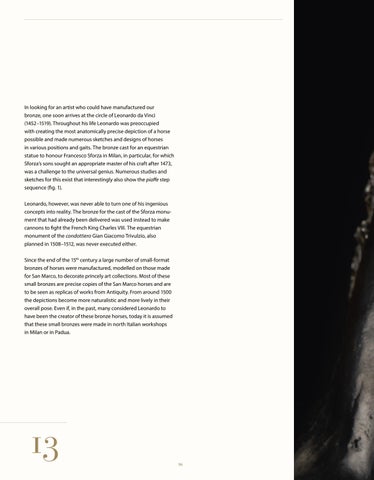In looking for an artist who could have manufactured our bronze, one soon arrives at the circle of Leonardo da Vinci (1452 –1519). Throughout his life Leonardo was preoccupied with creating the most anatomically precise depiction of a horse possible and made numerous sketches and designs of horses in various positions and gaits. The bronze cast for an equestrian statue to honour Francesco Sforza in Milan, in particular, for which Sforza’s sons sought an appropriate master of his craft after 1473, was a challenge to the universal genius. Numerous studies and sketches for this exist that interestingly also show the piaffe step sequence (fig. 1). Leonardo, however, was never able to turn one of his ingenious concepts into reality. The bronze for the cast of the Sforza monument that had already been delivered was used instead to make cannons to fight the French King Charles VIII. The equestrian monument of the condottiero Gian Giacomo Trivulzio, also planned in 1508 –1512, was never executed either. Since the end of the 15th century a large number of small-format bronzes of horses were manufactured, modelled on those made for San Marco, to decorate princely art collections. Most of these small bronzes are precise copies of the San Marco horses and are to be seen as replicas of works from Antiquity. From around 1500 the depictions become more naturalistic and more lively in their overall pose. Even if, in the past, many considered Leonardo to have been the creator of these bronze horses, today it is assumed that these small bronzes were made in north Italian workshops in Milan or in Padua.
13
96














